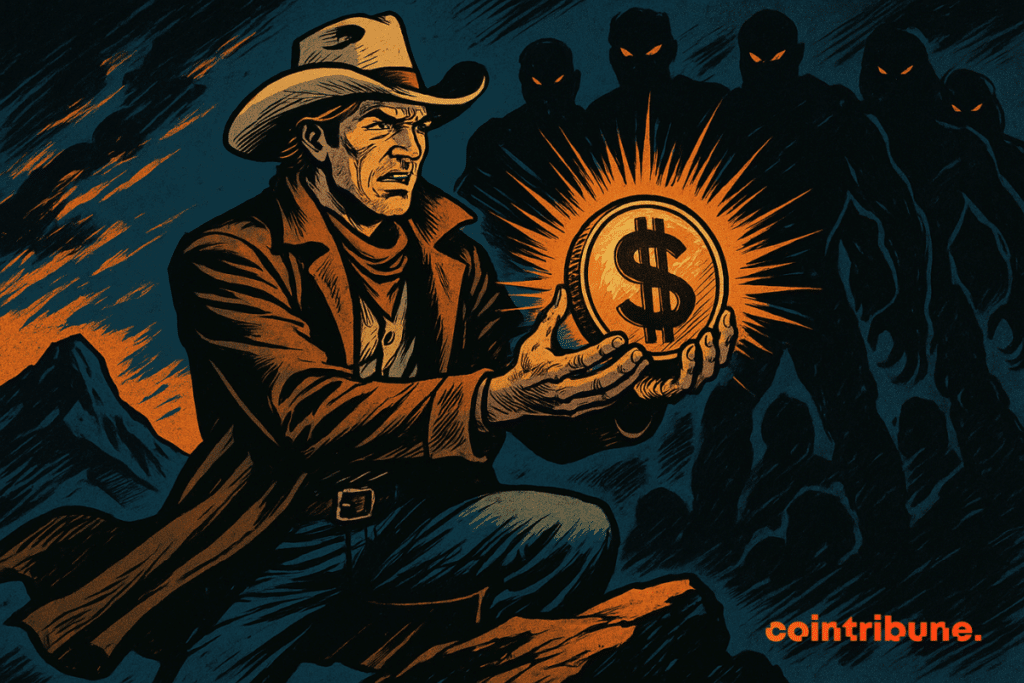Wyoming Deploys Its Stablecoin: Towards A Confrontation With The U.S. Government?
They love the smell of digital finance upon waking. Entire states in the United States, from the Capitol to the plains of Wyoming, are accelerating into the crypto turn. While Washington sets the groundwork for increased control, some states, like Wyoming, prefer the open air. There, stablecoin becomes a public matter. And the digital Trojan horses activate under the guise of innovation. Should we applaud the boldness or fear the abyss?

In Brief
- Wyoming creates WYST, a dollar-backed stablecoin, to modernize its public payments.
- The public stablecoin will be tested on Avalanche with instant payments to state contractors.
- Republican figures denounce a fake CBDC, dangerous for citizens’ privacy.
- WYST could inspire other states but remains legally uncertain facing the federal government.
WYST: a stablecoin to rule them all?
The Wyoming, a libertarian stronghold, does nothing like the others. After banning the creation of a CBDC on its soil, the state launches WYST, its own stablecoin backed by the dollar. Its purpose? To accelerate public payments, reduce costs, and fund… local schools. An ambitious project, supported by Senator Chris Rothfuss.
He is clear:
We are not faced with the same obligation to comply with a federal request that a corporation would be faced with. We have sovereignty, so when the government is in opposition, […] they can’t just send us a cease and desist letter and start arresting people.
To test this new crypto-asset, Wyoming relies on Hashfire, a startup that injects its protocols on Avalanche. The first use case: instant payment to state suppliers. A significant advance when average delays exceed 45 days. Rothfuss also promises a potential future token remuneration, turning WYST into a hybrid product.
Surveillance or sovereignty? The precarious balance of the public model
Not everyone applauds. Representative Tom Emmer, though a Republican, says he is firmly opposed to any tokenized version of a currency by a state. For him, WYST is just a disguised CBDC: “I personally am vehemently against any government issuing a tokenized version of its currency“.
But the director of the token commission, Anthony Apollo, reminds that Wyoming is not a central bank. He specifies that WYST will be fully backed by Treasury bonds, thus avoiding any inflationary risk.
This uncertainty shakes the red lines. The privacy promise? Still unclear. Data usage? To be defined. Censorship risks? Present. The state refuses to block transactions without judicial decision, but how long will this barrier hold up against a new administration? Wyoming tries to marry decentralization and authority, without a safety net.
Public crypto, fast finance: Wyoming does the math
While some see a gadget, Wyoming is advancing its pawns methodically. Tested on Avalanche, the WYST stablecoin aims to disrupt state payments. The goals? Efficiency, transparency, and profitability. Provided that political frictions do not blow up the experience.
John Belitsky, advisor to the WYST project, believes that other states could attempt the experiment, but that Wyoming’s philosophy, deeply attached to the Constitution, remains unique and difficult to replicate.
Here is what you need to remember about this state crypto project:
- WYST aims for an official launch in August, after a pilot on instant public payments;
- It relies on a customized Avalanche blockchain via AvaCloud, optimized for public smart contracts;
- Stablecoin remuneration is not activated yet but could be according to legislators;
- Generated revenues will directly fund Wyoming’s education system;
- Other states are watching closely but fear a showdown with Washington.
WYST could be a local revolution or a spark in a regulatory powder keg. The blaze awaits only a spark.
By claiming to stabilize the economy via stablecoins, states risk undermining its foundations. Senator Elizabeth Warren did not mince her words: she sees in this type of regulation a license to speculate under the guise of legality. For her, this illusion of security hides a control failure and could mirror an impending crisis. By decentralizing monetary issuance, states might very well light the fuse for a new unstable episode of digital capitalism.
Maximize your Cointribune experience with our "Read to Earn" program! For every article you read, earn points and access exclusive rewards. Sign up now and start earning benefits.
La révolution blockchain et crypto est en marche ! Et le jour où les impacts se feront ressentir sur l’économie la plus vulnérable de ce Monde, contre toute espérance, je dirai que j’y étais pour quelque chose
The views, thoughts, and opinions expressed in this article belong solely to the author, and should not be taken as investment advice. Do your own research before taking any investment decisions.